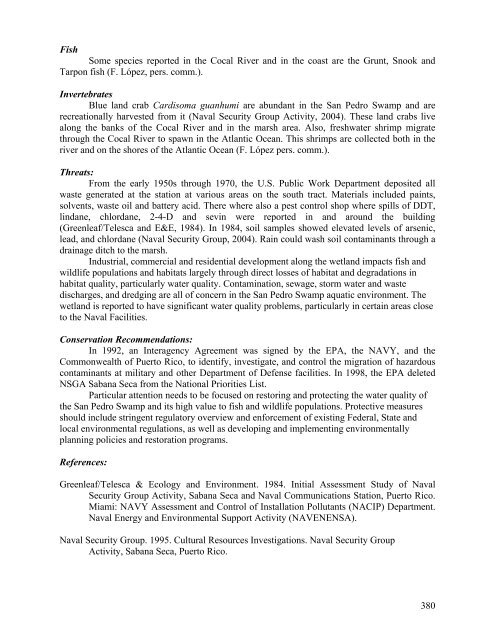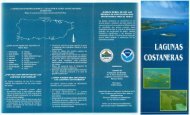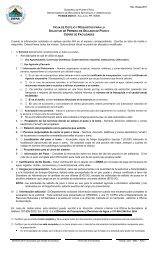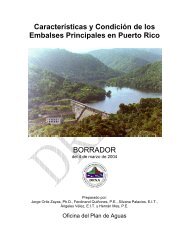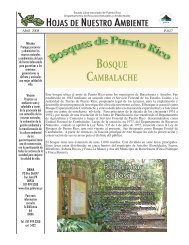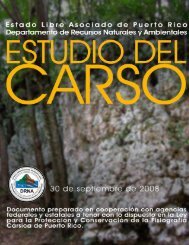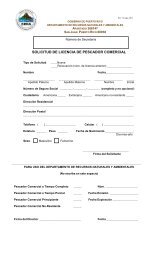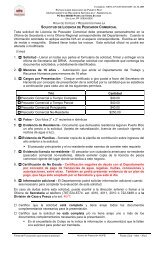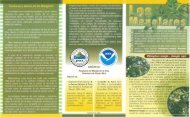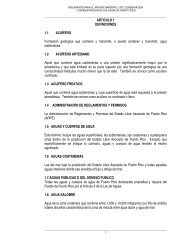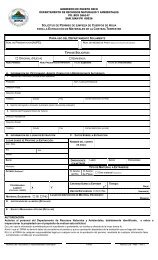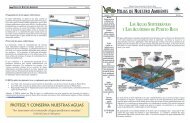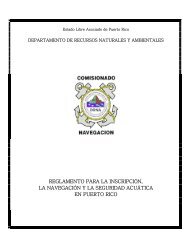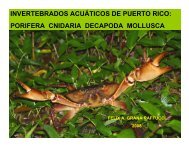Puerto Rico Critical Wildlife Areas - Puerto DRNA - Gobierno de ...
Puerto Rico Critical Wildlife Areas - Puerto DRNA - Gobierno de ...
Puerto Rico Critical Wildlife Areas - Puerto DRNA - Gobierno de ...
You also want an ePaper? Increase the reach of your titles
YUMPU automatically turns print PDFs into web optimized ePapers that Google loves.
Fish<br />
Some species reported in the Cocal River and in the coast are the Grunt, Snook and<br />
Tarpon fish (F. López, pers. comm.).<br />
Invertebrates<br />
Blue land crab Cardisoma guanhumi are abundant in the San Pedro Swamp and are<br />
recreationally harvested from it (Naval Security Group Activity, 2004). These land crabs live<br />
along the banks of the Cocal River and in the marsh area. Also, freshwater shrimp migrate<br />
through the Cocal River to spawn in the Atlantic Ocean. This shrimps are collected both in the<br />
river and on the shores of the Atlantic Ocean (F. López pers. comm.).<br />
Threats:<br />
From the early 1950s through 1970, the U.S. Public Work Department <strong>de</strong>posited all<br />
waste generated at the station at various areas on the south tract. Materials inclu<strong>de</strong>d paints,<br />
solvents, waste oil and battery acid. There where also a pest control shop where spills of DDT,<br />
lindane, chlordane, 2-4-D and sevin were reported in and around the building<br />
(Greenleaf/Telesca and E&E, 1984). In 1984, soil samples showed elevated levels of arsenic,<br />
lead, and chlordane (Naval Security Group, 2004). Rain could wash soil contaminants through a<br />
drainage ditch to the marsh.<br />
Industrial, commercial and resi<strong>de</strong>ntial <strong>de</strong>velopment along the wetland impacts fish and<br />
wildlife populations and habitats largely through direct losses of habitat and <strong>de</strong>gradations in<br />
habitat quality, particularly water quality. Contamination, sewage, storm water and waste<br />
discharges, and dredging are all of concern in the San Pedro Swamp aquatic environment. The<br />
wetland is reported to have significant water quality problems, particularly in certain areas close<br />
to the Naval Facilities.<br />
Conservation Recommendations:<br />
In 1992, an Interagency Agreement was signed by the EPA, the NAVY, and the<br />
Commonwealth of <strong>Puerto</strong> <strong>Rico</strong>, to i<strong>de</strong>ntify, investigate, and control the migration of hazardous<br />
contaminants at military and other Department of Defense facilities. In 1998, the EPA <strong>de</strong>leted<br />
NSGA Sabana Seca from the National Priorities List.<br />
Particular attention needs to be focused on restoring and protecting the water quality of<br />
the San Pedro Swamp and its high value to fish and wildlife populations. Protective measures<br />
should inclu<strong>de</strong> stringent regulatory overview and enforcement of existing Fe<strong>de</strong>ral, State and<br />
local environmental regulations, as well as <strong>de</strong>veloping and implementing environmentally<br />
planning policies and restoration programs.<br />
References:<br />
Greenleaf/Telesca & Ecology and Environment. 1984. Initial Assessment Study of Naval<br />
Security Group Activity, Sabana Seca and Naval Communications Station, <strong>Puerto</strong> <strong>Rico</strong>.<br />
Miami: NAVY Assessment and Control of Installation Pollutants (NACIP) Department.<br />
Naval Energy and Environmental Support Activity (NAVENENSA).<br />
Naval Security Group. 1995. Cultural Resources Investigations. Naval Security Group<br />
Activity, Sabana Seca, <strong>Puerto</strong> <strong>Rico</strong>.<br />
380


